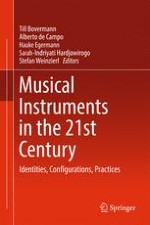2017 | OriginalPaper | Chapter
Machine Learning as Meta-Instrument: Human-Machine Partnerships Shaping Expressive Instrumental Creation
Author : Rebecca Fiebrink
Published in: Musical Instruments in the 21st Century
Publisher: Springer Singapore
Activate our intelligent search to find suitable subject content or patents.
Select sections of text to find matching patents with Artificial Intelligence. powered by
Select sections of text to find additional relevant content using AI-assisted search. powered by
